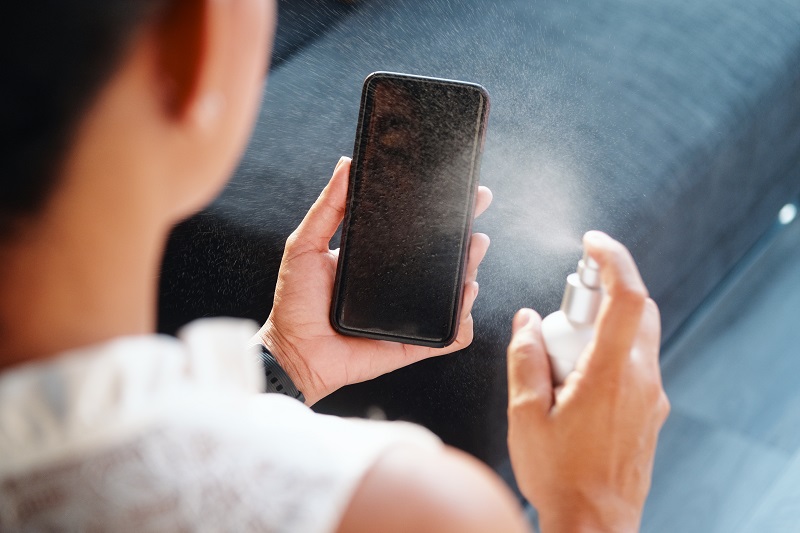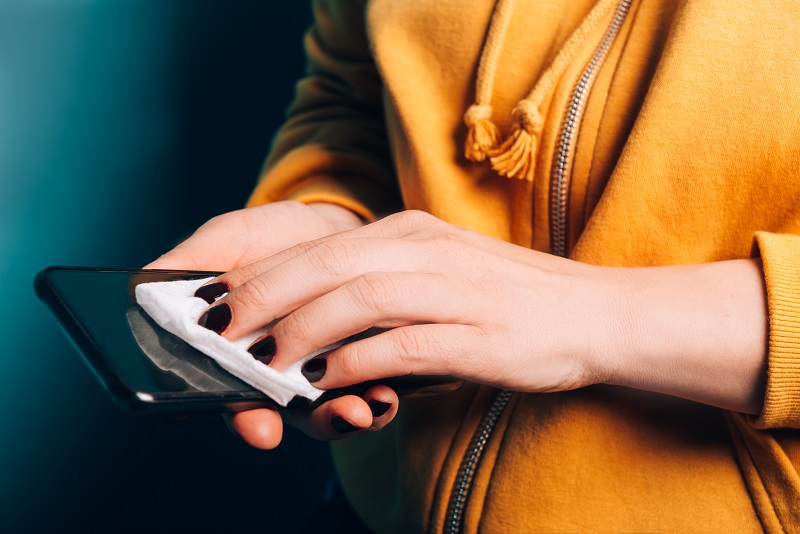
Disinfecting your cell phone is as important as washing your hands. Health experts share their best tips for how to safely clean and disinfect your cell phone without damaging it, whether it’s an iPhone or an Android, during COVID-19.
As you struggle with the rapidly spreading COVID-19, you’ll want to pay special attention to cleaning up and disinfecting the surfaces that could transmit it. Experts fear that the new coronavirus might live on surfaces for up to several days, and a March 2020 article in The New England Journal of Medicine notes that the virus causing COVID-19, SARS-CoV-2, can live up to three days on plastic and stainless steel surfaces and up to three hours in the air. Unfortunately, not many people disinfect surfaces as often as they should, and even more, people neglect to regularly clean one of the surfaces they touch the most during the day: Their cell phone.
“We don’t have much information about how long viruses remain infectious on cell phones. Environmental conditions do affect this a lot, so our limited data on how long SARS-CoV-2 remains on some surfaces (plastic, stainless steel, cardboard, etc) might not apply to various real-life situations,” explains Angela Rasmussen, PhD, virologist at Columbia University’s Center for Infection and Immunity, urging good hygiene and cleanliness.
Inevitably, people touch their cell phones many times throughout the day to check or send texts, emails, and make/receive calls. It is also a fact that people have a tendency to regularly touching their faces, up to 23 times per hour, according to a 2015 study from the American Journal of Infection Control. So you see now why it is so important to disinfect your phone, considering that you’re using it every hour of the day, you’re potentially exposing yourself to a lot of germs.
To help you practice good cell phone hygiene during the COVID-19 pandemic, take a look at what you need to know about disinfecting your phone properly, keep yourself healthy, and the most important thing, stay home.
Your cell phone has plenty of germs
I guess it’s shouldn’t be surprising for anyone that a cell phone is practically a petri dish for germs, and that’s because everywhere you go, your phone goes with you, and so do the surrounding germs. According to a 2018 study published in the International Journal of Environmental Research and Public Health, out of 25 mobile phones studied, 92 percent were contaminated with bacteria. Meanwhile, a 2017 study published in Germs found that some high school students’ cell phones carried on average more than 17,000 bacterial gene copies.
Elizabeth Garman, a spokesperson of the Association for Professionals in Infection Control and Epidemiology, says, “There is some evidence to suggest that the virus can survive up to a few days on surfaces. But based on what we know so far, COVID-19 is mainly spread by close person-to-person contact from droplets from a cough or sneeze, which can get into your mouth, nose, or lungs.”
However, even if your phone is spotlessly clean, social distancing is still necessary these days. But with COVID-19 cases multiplying exponentially day by day, keeping your phone germ-free is vital.
Disinfect your cell phone daily
The Centers for Disease Control and Prevention (CDC) recommends that people should regularly “clean and disinfect frequently touched surfaces and objects.” They specifically refer to electronics including cell phones, computers, touch screens, and remote controls.
They advise putting a wipeable cover on electronics, follow your manufacturers’ cleaning and disinfecting recommendations, and in the absence of instructions, you can safely use alcohol-based wipes or sprays with at least 70 percent alcohol before drying surfaces thoroughly.
“We have always been too lax about cleaning our phones and now it is more important than ever,” says Georgine Nanos, MD, MPH, is a board-certified family physician specializing in epidemiology and chief executive officer of Kind Health Group, a company that offers aesthetic care. “You should disinfect and clean your cell phone every time you wash or sanitize your hands.
And definitely anytime you pick it up and put it to your face if you have set it down on a potentially contaminated surface.”
Additionally, the CDC advises wearing gloves while cleaning, but at the same time, if you have access to gloves considering that they’re very hard to find these days, make sure you’re not hoarding them, as they’re essential to health care workers.
How to clean your iPhone
Until recently, Apple hadn’t made public the fact that iPhones could be safely disinfected. On the contrary, they had actively warned against using “cleaning products,” which could ruin the coating. However, earlier this month, Apple gave the “OK” for the use of disinfectants to clean your phone.
According to Apple’s updated guidelines, you can use a 70 percent isopropyl alcohol wipe or Clorox Disinfecting Wipes to wipe “the hard, nonporous surfaces of your Apple product, such as the display, keyboard, or other exterior surfaces.” However, the company advises not to use bleach or getting moisture in openings, such as the charging port. Lastly, Apple warns its consumers to not submerge the phone in cleaning agents.
Ran out of cleaning wipes? Apple also recommends soft, damp, lint-free cloths, such as lens cloths, either used alone or with warm water and soap.

How to clean your Android
Unlike iPhones, Androids are comprised of a variety of devices from many companies, including Samsung, Nokia, and Google. This means that when it comes to cleaning and disinfecting your phone, there’s not one catch-all answer. It would be better to check your individual manufacturer’s website for instructions because you don’t want to damage your phone.
For example, for Nokia phones, the company offers two options to clean and disinfect your phone. They recommend cleaning phones with water and light soap or using 70 percent isopropyl alcohol wipes. When using wipes, Nokia advises avoiding open ports or openings, and to finish with a clean microfiber cloth.
Additionally, Samsung recommends disinfectants such as a hypochlorous acid-based solution (containing 50-80 ppm) or an alcohol-based solution (containing more than 70 percent ethanol or isopropyl alcohol) on its phones, according to their website. However, the company cautions against applying them to the phone directly. Instead, they suggest carefully applying them to a microfiber cloth first.
Nevertheless, Google recently updated its cleaning guidelines for their Pixel phones by suggesting the use of regular household disinfecting wipes or 70 percent isopropyl alcohol-based wipes. The company advises against using wipes that have bleach.
How to clean your cell phone case
Cleaning and disinfecting practices are slightly different when it comes to phone cases because unlike most phones, which are made up of glass and metal, phone cases can be made of plastic, silicone, or natural leather. For example, when it comes to cleaning a silicone iPhone case, Apple recommends removing the iPhone from its case first and then using a slightly damp lint-free cloth for wiping both the outside and inside of the case. On their website, they uploaded a list of products (window cleaners, household cleaners, etc.) you should avoid using for cleaning your case.
Can disinfectants damage your cell phone?
Phones have something called an oleophobic layer, which is a thin, oil-repelling material that helps resist greasiness and fingerprint smudges. It was previously believed that alcohol-based disinfecting agents would damage this smudge-resistant coating. However, as previously mentioned, phone manufacturers have revised their guidelines during COVID-19 and recommend the use of disinfecting wipes. Moreover, it’s important to remember, as per Apple’s advice, chemicals like bleach can be too harsh and damage the screen.
If you’re unwilling to use chemicals on your phone, the all-things-Android site Android Central recommends using Q-Tips or felt-tipped swabs to swab the earpiece, ports, and speaker, then wiping down the screen and body with a mobile screen wipe, followed by a microfiber cloth or clean kitchen towel. Additionally, using a microfiber cloth won’t kill viruses, but it may help remove them.
Moreover, all manufacturer websites agree that you should stay away from compressed air devices because it could damage the inside of your phone.
Wear gloves and keep washing your hands
As the CDC recommends, you should always wear gloves when planning to handle chemicals such as Clorox or Lysol wipes to clean your device. Don’t forget to remove the phone from its case, especially if your case is made of leather, and to wipe the case, too, if it’s a material like plastic, steel, or rubber. Then all you have to do is let the cleaning solution dry fully before putting your case back on.
Once you’re completely done with cleaning your phone, throw away the gloves and wash your hands for 20 seconds. A clean phone surface is not very important if your hands are coming into contact with germs shortly after. Additionally, make sure to keep your hands away from your face in-between hand washings.
“The single best defense for all of us is still frequent handwashing with regular soap and water, and if you don’t have access to soap and water then use an alcohol-based hand sanitizer with greater than 60 percent alcohol,” explains Dr. Nanos. She advises people to disinfect their phones at the same time they disinfect hands. “Avoid touching your face or putting your phone to your face if you have not had the opportunity to disinfect your hands or your phone.” Dr. Nanos stresses that you can’t actually catch the virus through your hands. But, “it’s when your hands touch your eyes nose or mouth that you have the potential to become infected,” she says.
Nevertheless, social distancing (and self-quarantining if you feel sick) is vital. “The most important thing people can do to protect themselves is stay home and physically distance themselves from others,” says Rasmussen.











































